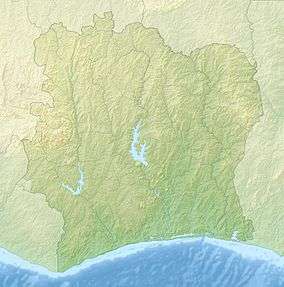Mount Richard-Molard
| Mount Richard-Molard | |
|---|---|
 Mount Richard-Molard Location of Mount Nimba in Côte d'Ivoire (on the Guinean border) | |
| Highest point | |
| Elevation | 1,752 m (5,748 ft) |
| Listing | Country high point |
| Coordinates | 7°37′21″N 8°24′20″W / 7.62250°N 8.40556°WCoordinates: 7°37′21″N 8°24′20″W / 7.62250°N 8.40556°W |
| Geography | |
| Location | Côte d'Ivoire – Guinea |
Mount Richard-Molard is a mountain along the border of Côte d'Ivoire and Guinea in West Africa. At 1,752 m (5,750 ft) it is the highest point in both nations, and it is the second highest point in West Africa, west of Cameroon. The mountain is the highest peak of the Nimba Range (the "Guinean Backbone"), which straddles the borders between the two countries and Liberia. The nearest major settlement are the town Yekepa to the west in Liberia and Bossou in Guinea.[1]
Toponymy
The mountain is named after the French geographer Jacques Richard-Molard, who died in an accident at the mountain site in 1951.[2] Before that it was called Mount Nouon.[3]
Conservation
Since 1944 the area, excluding Liberia's portion, has been a nature reserve. Currently covering 180 km², the Mount Nimba Strict Nature Reserve is classified as a World Heritage Site, including Guinean montane forests, Western Guinean lowland forest and Guinean forest-savanna mosaic. Mount Nimba Strict nature Reserve, including Mount Richard-Molard lies within Guinean Forests of West Africa biodiversity hotspot.
Minerals
The mountain is rich in iron ore and cobalt. There was intensive mining in the Liberian portion of the mountain until reserves were exhausted in 1989. The mix of iron-quartzite sheets, schists and granitogneiss has produced startling land formations by soil erosion.
World Heritage status
This site was added to Guinea's "Tentative List" for consideration for UNESCO World Heritage Site status on 29 March 2001 in the cultural category.[4]
Mount Nimba Strict Nature Reserve has been listed as a World Heritage Site in both Guinea and Côte d'Ivoire since 1981 under the criteria for natural heritage.[5]
See also
References
- ↑ Colombant, Nico (30 January 2008)."Villagers Resist Environmentalists Around Guinea's Mount Nimba". Voice of America.
- ↑ Westermann, Diedrich; Smith, Edwin William; Forde, Cyril Daryll (1951). Africa. Oxford University Press. p. 335. OCLC 50238863
- ↑ Pugh, John Charles; Morgan, W. B. (1969). West Africa. London: Methuen. ISBN 0-416-26900-1.
- ↑ Paysage culturel des monts Nimba, UNESCO World Heritage Centre. (in French)
- ↑ "Mount Nimba Strict Nature Reserve". UNESCO World Heritage Centre. Retrieved 2016-11-25.
External links
- World Heritage Site Data Sheet–Mount Nimba Strict Nature Reserve
- Rollard Ch., Wesolowska W. 2002. Jumping spiders (Arachnida, Araneae, Salticidae) from the Nimba Mountains in Guinea. Zoosystema. Paris, 24 (2):283-307
- TLC Africa
- MSN Map